
Featured Image Credit: SWNS
A Brazilian man who had the rare opportunity to fly over the Great Pyramid of Giza has captured footage of the writing hidden at the top of it.
The closest most visitors get to flying over the pyramids is when their flight comes in to land in Egypt, but with the help of his paramotor, 35-year-old Yanis Terzis got a much closer look.
The pilot and psychiatric administrator, from Campinas, Brazil, took himself on a flight over a number of ancient Egyptian sites, including the Sphinx, when he travelled to Cario and Luxor in Egypt for a paramotor event.
Similar to a regular paraglider, a paramotor uses a wing to stay in the air, but has the added feature of a huge fan which helps to propel the pilot. After adding his trusty GoPro Hero 10 to his helmet, Terzis was off on his adventure.

He explained: “Most of the paramotor pilots fly high for safety precautions.
“Sometimes I like to get a little bit risky on my flights and go close to the ground and over the building to get amazing shots and videos.
“This was what happened with the Pyramids and temple flight, amazing footages that has been shared in YouTube with more than 7 million views.”
Terzis had been granted permission to fly over the pyramids, meaning he wasn’t breaking the law with his flight, and he hoped to capture ‘some of the most amazing footage from a different angle over the pyramids and temples’.
The pilot actually got so close that he was able to touch the tip of the pyramids with one of his feet – a moment he will ‘remember for the rest of [his] life’.
Since most people only see the pyramids from the ground, Terzis noted that most don’t know what they look like at the top.

He made reference to ‘scriptures and graffiti’ at the top of the pyramids, with a close look at his video showing words carved into the white stone.
Terzis added: “Also, the incredible view in 4k give another perspective, and you can see all the details from the monuments.”
Footage from Terzis’ flight shows him skimming over the top of the pyramids – which are actually more flat than pointed at the top – and looking down over the Sphinx.
The Pyramids of Giza are often considered one of the Seven Wonders of the World, with the largest, the Great Pyramid of Giza, having been completed in about 2560 BCE.
The pyramid originally stood about 482 feet tall, but erosion and the removal of some of the stones have lowered its pyramid’s height to around 449 feet.
Robot captures never-before-seen footage uncovering secrets from inside Great Pyramid of Giza
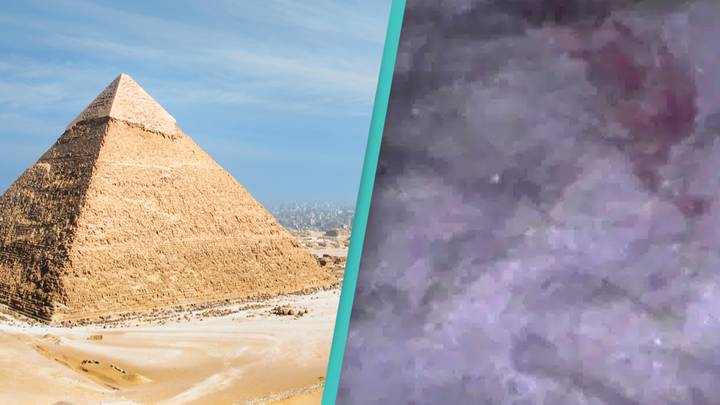
Featured Image Credit: Nick Brundle Photography/ leeds.ac.uk
For years people have wondered what’s inside the Great Pyramid of Giza, sparking dozens of archeological digs.
But, there’s only so far these digs had taken researchers as some parts of the 4,500 year old Egyptian pyramid are too small for humans to get to.
Until now that is, as a robot has obtained never-before-seen footage from unexplored areas of the pyramid. Check it out below:
What’s described as a ‘blocking stone’ in the Queen’s Chamber was discovered in the pyramid in 1993, but what was behind it and the purpose of it has long remained a mystery.
The shaft sits at an awkward 40-degree angle, and measures only 20cm by 20cm.
While only small, it goes back as a far as 60 meters.
Fast forward to 2011 and a team of researchers decided to create a robot that could film the inside of the shaft to see what was inside.
Dubbed ‘The Djedi Project’, international and Egyptian experts came together to create the device.
The team was managed by the University of Leeds, UK, and supported by Dassault Systèmes in France.
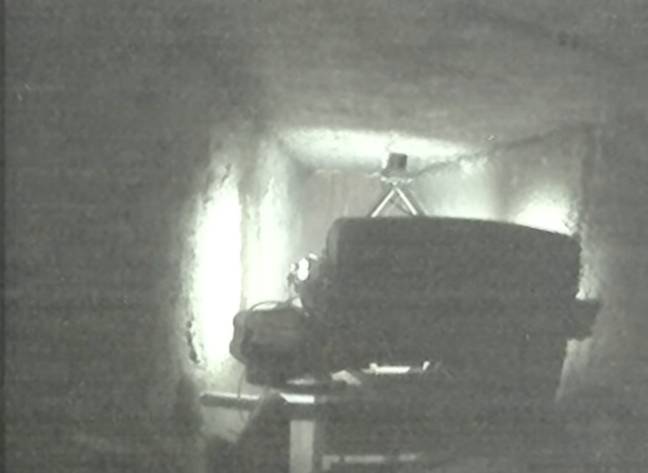
Speaking about the robot, Professor Rob Richardson, part of the Robotics at Leeds research group, said: “This design was certainly challenging. The robot had to be extremely lightweight – and in the end we got it down to 5kg.
“Because it was so light, it did not require a lot of power – in the end, the challenges started to become opportunities.
“We developed a system that moved the robot very gently through the passageway.”
While challenging, the team successfully managed to develop the robot. It took them five years to create.
The project went on to film and whopping nine hours of raw footage, and the footage unveiled some secrets from within the shaft.
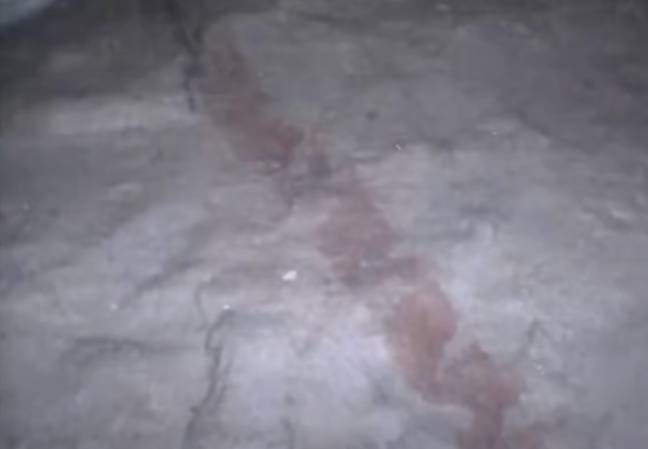
“About 50 meters along the shaft – several meters before what we think is the end, there is a stone put in place to block further access,” said Professor Richardson.
“We do not know what that stone is blocking access to. We were able to get a camera past the stone – it revealed a small chamber with intricate symbols painted on the floor.”
With the artwork in mind, Professor Richardson suggested that the shaft ‘served a bigger purpose than act as an air vent’.
That purpose is still unclear, however.
Back in 2020, a documentary on the project was released titled The Robot, The Dentist and The Pyramid.
The name of the documentary gives the nod to Hong Kong dentist and inventor Dr Tze Chuen Ng, who threw down the challenge of creating the bot to explore the pyramid.
The Robot, The Dentist and The Pyramid is available to watch on the Ancient Architects YouTube channel here.
Japan’s ancient underwater ‘pyramid’ remains one of the world’s great mysteries

Featured Image Credit: Unveiled/YouTube
While Atlantis may only be a myth, this Japanese monument might be the closest thing to a real-life version of it.
Labelled the Yonaguni Monument, the pyramid-like structure was discovered by Kihachiro Aratake, a local diver, in 1987.
The top of the nine meter tall monument is a mere five meters below the surface, and is located near Japan’s Yonaguni island.
It’s believed that it could be the ruins of what once was a civilisation dating back as far as 10,000 years.
Some are convinced that there are remains of what looks to have once been castles, temples, a stadium, and even roads.
Recalling the moment he came across the monument, Aratake said he was ‘very emotional’.
“I stumbled upon it by pure coincidence,” the told the BBC.
“I was very emotional when I found it.
“Upon discovering it, I realized that this would become a treasure of Yonaguni island.
“I kept it a secret. I didn’t tell anyone on my staff.”

Following his discovery, a team of scientists started to research the mysterious rock formations alongside Aratake.
Professor Masaaki Kimura, of Ryukyu University, went on to label it as ‘very difficult to explain away their origin as being purely natural’ in light of ‘the vast evidence of man’s influence on the structures’.
Meanwhile, Aratake said it was the monuments ‘spiral staircase’ that convinced him that it was man-made.
As to who built it, one theory is that it was created by Jōmon people: hunter-gatherers who inhabited the islands as early as 12000 BC.
Many geologists have since studied the Yonaguni Monument for themselves and, while it could well be Japanese Atlantis, many have argued that it’s just an unusual natural formation.

Robert Schoch, a professor at Boston University who has explored the site himself, previously told National Geographic: “It’s basic geology and classic stratigraphy for sandstones, which tend to break along planes and give you these very straight edges, particularly in an area with lots of faults and tectonic activity.”
Ryukyu University’s Takayuki Ogata also thinks it was formed naturally. He went to visit the famous site in 2016.
“Upon first seeing it I immediately knew that the formations were similar to those on land,” he said to the BBC.
“I’ve researched a lot of sites and done a lot of field work, but this was the first time I’d seen formations that were continuous from land to water.”
Both sides of the argument for the Yonaguni Monument origins are yet to be proven right, leaving it as one of the world’s biggest mysteries.
Mysterious tunnel has been found inside Great Pyramid of Giza
.png)
Featured Image Credit: The Egyptian Ministry of Antiquities / Zoonar GmbH / Alamy Stock Photo
Scientists have discovered a nine-metre hidden passageway inside the Great Pyramid of Giza that could help explain some of the ancient structure’s mysteries.
The pyramids in Egypt are among the most fascinating structures ever built.
Conspiracy theories about aliens and unknown civilisations continue to swirl around them until this very day.
However, there’s still some very real science and exploration being done on them, and – incredibly – we still keep learning more about them, even thousands of years after they were built.
Inside the Pyramid of Khufu, which is the largest of the pyramids in Giza, a team of researchers have discovered a mysterious passageway, the Egyptian tourism and antiquities minister has announced today.

As tends to be the way with the pyramids, we don’t actually know what the passageway was for just yet, but it could definitely bring about more interesting discoveries now that the right people know it’s there.
To be fair, some people will also claim that it could unleash a darkness and curse that has been imprisoned in the ancient tomb for millennia, but you’d better believe the scientists will take that chance.
This latest discovery was made by a research team from a project called Scan Pyramid.
See if you can guess what they do.
Since 2015, the group has been using modern technology to see what the inside of the pyramid looks like from the outside, with scanners and infrared thermography among other tools.
Apparently, the ceiling of the tunnel shows it was built to relieve the weight of the pyramid, according to Mostafa Waziri, the head of the Egyptian Supreme Council of Antiquities.
“But a big question mark hangs over whether this corridor was created to relieve the weight on the [main] entrance or lighten the load on a space yet to be discovered,” he said.
“Scanning work will continue to uncover more secrets.”
Let’s hope so.
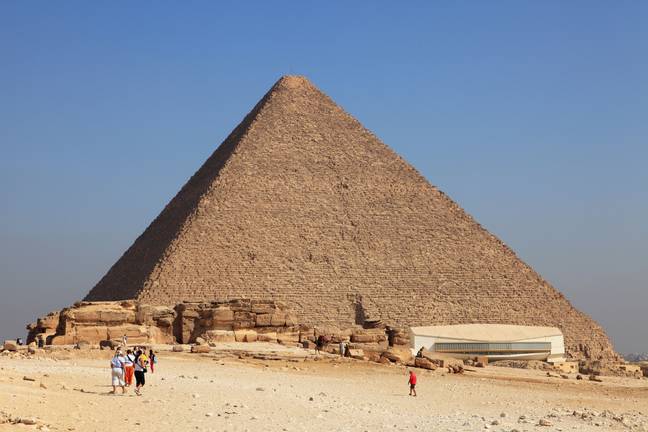
The pyramid was built some 4,500 years ago during the time of Pharoah Khufu, and continues to draw people from around the world to it.
That means big money from tourism for the government of Egypt if they can cash in on the interest that people have.
After Covid-19 and political unrest have taken their toll on the industry, they’ll be hoping that scientific discoveries like these will increase the enduring fascination in the world of ancient Egypt.
Maybe one day we’ll uncover all of their secrets.
Mysterious doors in Great Pyramid of Giza hiding ‘secrets’ to be unlocked for first time
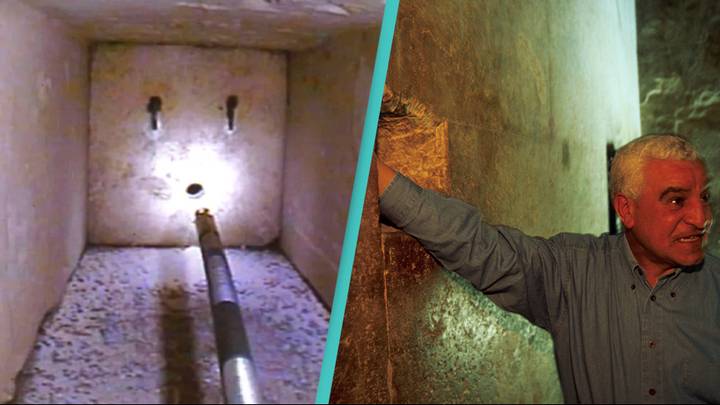
Featured Image Credit: National Geographic / Patrick CHAPUIS/Gamma-Rapho via Getty Images
Ancient Egypt has remained one of the most fascinating periods of time for archeologists, and one hopes to now reveal some of its hidden secrets connected to the pyramids.
The former Minister of State for Antiquities Affairs of Egypt, Zahi Hawass, has excitedly outlined his hopes for an upcoming expedition deeper into the pyramids in Giza.
Seemingly tapping into his inner Rick O’Connell, Hawass has said he hopes to uncover the secrets within the Pyramid of Khufu.
Speaking to The US Sun, he detailed that there were a series of doors that are difficult to access and no one knows essentially where they go.
He noted that while he had already made discoveries inside the Great Pyramid of Khufu, it only left him with more questions that needed answers.
“I think, until now, the secret doors that I found inside the Great Pyramid are really a discovery that needs many questions and many answers,” he told the publication.
“Inside the Great Pyramid, I found the so-called three doors. One on the south entrance of the second chamber that has two copper handles.
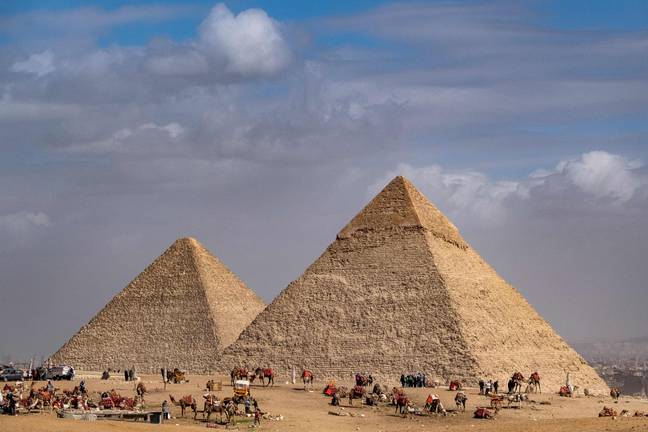
“Twenty-one centimeters behind that one we found a second one and in the northern tunnel, we found the third door with two copper handles.
“On December 5th I’m leading a team, to see, to discover, and to answer the questions about these doors.”
Hawass has previously written about the fascination surrounding the pyramids and insisted the Khufu pyramid remains popular to archeologists due to its very complex interior.
Speaking of his upcoming December 5th Hollywood-worthy adventure, he said the discovery of more doors or passages could help give a greater understanding of the purposes surrounding the pyramids interior design.
“We are planning to clean the south shaft from outside to learn if it does open to the outside,” he said.
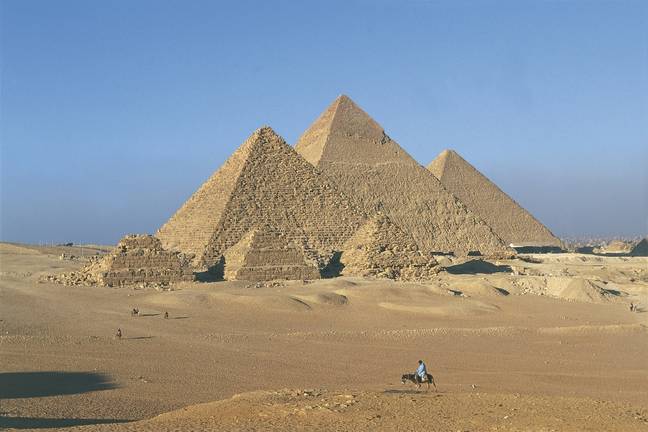
“If it does, then it is possible that it was a symbolic door for the king to use in crossing to the Netherworld.
“If it is sealed, we have to return to the Westcar Papyri and read how Khufu was looking for the documents of the god Thoth to help him with the design of his pyramid.
“Only further research into the shafts can reveal their function, solving one of the many mysteries of the Great Pyramid.”
We can only hope that the famed archeologist doesn’t stumble upon any flesh-eating scarabs. All the best to him.
